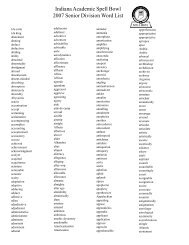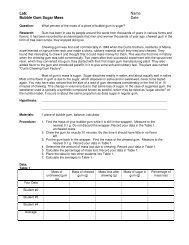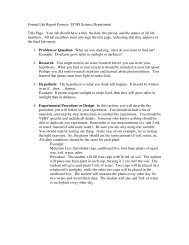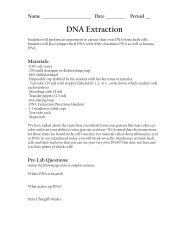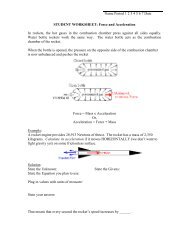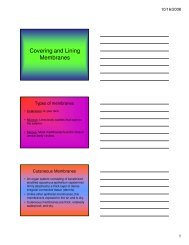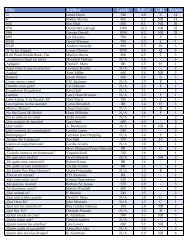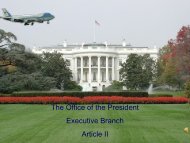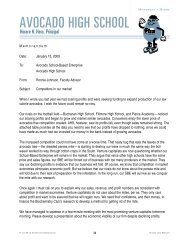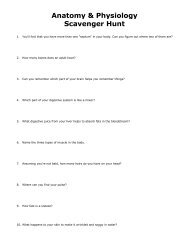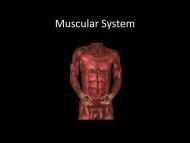Circular Flow and Market Structure Notes
Circular Flow and Market Structure Notes
Circular Flow and Market Structure Notes
Create successful ePaper yourself
Turn your PDF publications into a flip-book with our unique Google optimized e-Paper software.
R u n n i n g i n P l a c e<br />
<strong>Market</strong> System<br />
Economics Review<br />
<strong>Circular</strong> <strong>Flow</strong><br />
The basic coordinating mechanism of a capitalist economy is a market (<strong>and</strong> the price<br />
system). Capitalism is a market economy. Decisions are made by buyers <strong>and</strong> sellers of<br />
products (in the product market) <strong>and</strong> resources are turned into products via the exchange<br />
of resources (in the factor market). In our problem, the product market is the market in<br />
which shoes are bought <strong>and</strong> sold <strong>and</strong> the (primary) factor market is the market in which<br />
labor is hired <strong>and</strong> paid wages.<br />
The preferences of sellers <strong>and</strong> buyers are registered on the supply <strong>and</strong> dem<strong>and</strong> sides of<br />
the markets. The outcome of these choices is a system of product (e.g. shoes) <strong>and</strong> resource<br />
(e.g. labor) prices. These prices provide households (as resource owners <strong>and</strong> consumers)<br />
<strong>and</strong> firms (as resource purchasers <strong>and</strong> producers) with information to make <strong>and</strong> revise<br />
decisions in furthering their self interests.<br />
The market system is an elaborate communication system through which innumerable<br />
individual choices are recorded, summarized, <strong>and</strong> weighted against each other. Prices<br />
are the means of communication. Firms <strong>and</strong> households who pay attention to the<br />
market’s signals (i.e. prices) are rewarded while those who ignore the market’s signals<br />
are penalized. Through the price communication system <strong>and</strong> individual responses to it,<br />
society decides what the economy should produce, how production is organized, <strong>and</strong><br />
how rewards <strong>and</strong> penalties are distributed. That is, the market system is the mechanism<br />
through which society decides how to allocate resources <strong>and</strong> distribute output as well<br />
as the system through which these decisions are carried out. In societies that are not<br />
grounded in capitalism, these decisions are made through non-market mechanisms (e.g.<br />
government, tradition).<br />
Operation of a <strong>Market</strong>-Based Economy<br />
In a free market, money-based economy, households, as resource owners, sell their<br />
resources to firms for money income. As consumers, households spend their money<br />
income buying goods <strong>and</strong> services. Firms must spend money in order to buy the resources<br />
used to produce goods <strong>and</strong> services. Their finished products are then sold to households in<br />
exchange for money. The net result is a counter clockwise real flow of economic resources<br />
<strong>and</strong> finished goods <strong>and</strong> services <strong>and</strong> a clockwise money flow of income <strong>and</strong> consumption<br />
expenditures (see diagram in Appendix IV). These flows are simultaneous <strong>and</strong> repetitive.<br />
The <strong>Circular</strong> <strong>Flow</strong> diagram illustrates the flow of real resources <strong>and</strong> money in a marketbased<br />
economy. In this economy, there are two groups of decision makers—households<br />
<strong>and</strong> firms.<br />
The coordinating mechanism that brings the decisions of households <strong>and</strong> firms into<br />
alignment with one another is the market system.<br />
© 2007 Buck Institute for Education 35<br />
August 2007 Version
R u n n i n g i n P l a c e<br />
Factor <strong>Market</strong><br />
The bottom half of the diagram shows the Factor <strong>Market</strong>. In this market consumers<br />
(households), who directly or indirectly (through their ownership of business corporations)<br />
own all economic resources, supply resources to producers (firms). Producers, of course,<br />
dem<strong>and</strong> resources because they are the means by which goods <strong>and</strong> services are produced.<br />
[Note: the interaction of dem<strong>and</strong> <strong>and</strong> supply for resources in the factor market establishes<br />
the price of each resource]. The payments that firms make in obtaining resources are their<br />
costs, but simultaneously constitute flows of wages, rent, interest, <strong>and</strong> profit income to the<br />
households supplying these resources.<br />
Labor is used as the primary example of a resource in this problem but renting or buying<br />
the robotics is also an example. Resource scarcity in this market can best be illustrated<br />
by the fact that firms must pay for resources. If resources were unlimited (e.g. air), firms<br />
would not have to pay to obtain them. Anthony Beckett is the most dramatic example of<br />
a scarce resource. Because there are limits to the number of individuals with his skills,<br />
shoe companies bid up the price to pay for his endorsement. In contrast, air, because it is<br />
virtually unlimited, carries no price <strong>and</strong> would be costless as a resource in the production<br />
of shoes.<br />
U Potential Hurdle: Students often have difficulty seeing that households supply<br />
resources other than labor to the factor market. It is fairly easy for students to see<br />
that labor is paid wages to enter the “factor market.” Students can also be shown that<br />
households get interest on monies they loan to firms for purchase of capital that is used<br />
in the factor market, rent on l<strong>and</strong> that is used in the factor market, <strong>and</strong> profit to savvy<br />
entrepreneurs.<br />
Product <strong>Market</strong><br />
The top half of the diagram shows the Product <strong>Market</strong>. The money income received<br />
by households from the sale of resources does not, as such, have real value for them.<br />
Consumers cannot eat or wear coins <strong>and</strong> paper money. Hence, through the expenditure of<br />
money income in the product market, households express their dem<strong>and</strong> for a vast array<br />
of goods <strong>and</strong> services. Simultaneously, producers combine the resources that they have<br />
<strong>and</strong> supply goods <strong>and</strong> services in the same market. The interaction of these dem<strong>and</strong> <strong>and</strong><br />
supply decisions determines product prices. Note that the flow of consumer expenditures<br />
(money) on goods <strong>and</strong> services constitutes sales revenues for producers.<br />
<strong>Circular</strong> <strong>Flow</strong> of Resources<br />
As the diagram implies, a complex, interrelated web of decision making <strong>and</strong> economic<br />
activity exists within a market economy. Both consumers <strong>and</strong> producers participate in<br />
both markets, but on different sides of each. Producers are on the buying (dem<strong>and</strong>) side<br />
of the factor markets, <strong>and</strong> consumers (as resource owners) are on the supply side. In the<br />
product market, these positions are reversed. Households, as consumers, are on the buying<br />
(dem<strong>and</strong>) side of product markets <strong>and</strong> firms, as producers, are on the selling side.<br />
Scarcity<br />
Scarcity underlies all of the transactions portrayed in this diagram. Because households<br />
have only limited amounts of resources to supply to firms (e.g. limited time, abilities), the<br />
© 2007 Buck Institute for Education 36<br />
August 2007 Version
R u n n i n g i n P l a c e<br />
household’s money income is limited. This means that each consumer’s income will go<br />
only so far in the purchasing of goods <strong>and</strong> services. A limited number of dollars clearly<br />
will not permit the consumer to buy all of the goods <strong>and</strong> services desired. Similarly<br />
because resources are scarce, there are limits to the number of goods <strong>and</strong> services that<br />
can be produced. Scarcity <strong>and</strong> choice should permeate the entire discussion of the flow of<br />
resources.<br />
Money<br />
Although money performs many functions in an economy, its most important function<br />
is that of a medium of exchange. Consumers must trade or exchange their labor (for<br />
example) for goods <strong>and</strong> services desired. Because consumers want a wide variety of<br />
products, they would have to provide their resources to diverse types of firms to obtain<br />
variety in goods consumed unless money is used to facilitate exchange. For example,<br />
without money if a person wanted only food, clothes <strong>and</strong> shelter, s/he would have to<br />
provide labor for a farmer, cloth maker, <strong>and</strong> construction contractor to obtain these goods<br />
in payment. This would be quite inconvenient. Instead, the consumer can provide labor to<br />
any firm <strong>and</strong> be paid in money that can be used to purchase a wide variety of goods <strong>and</strong><br />
services.<br />
© 2007 Buck Institute for Education 37<br />
August 2007 Version



